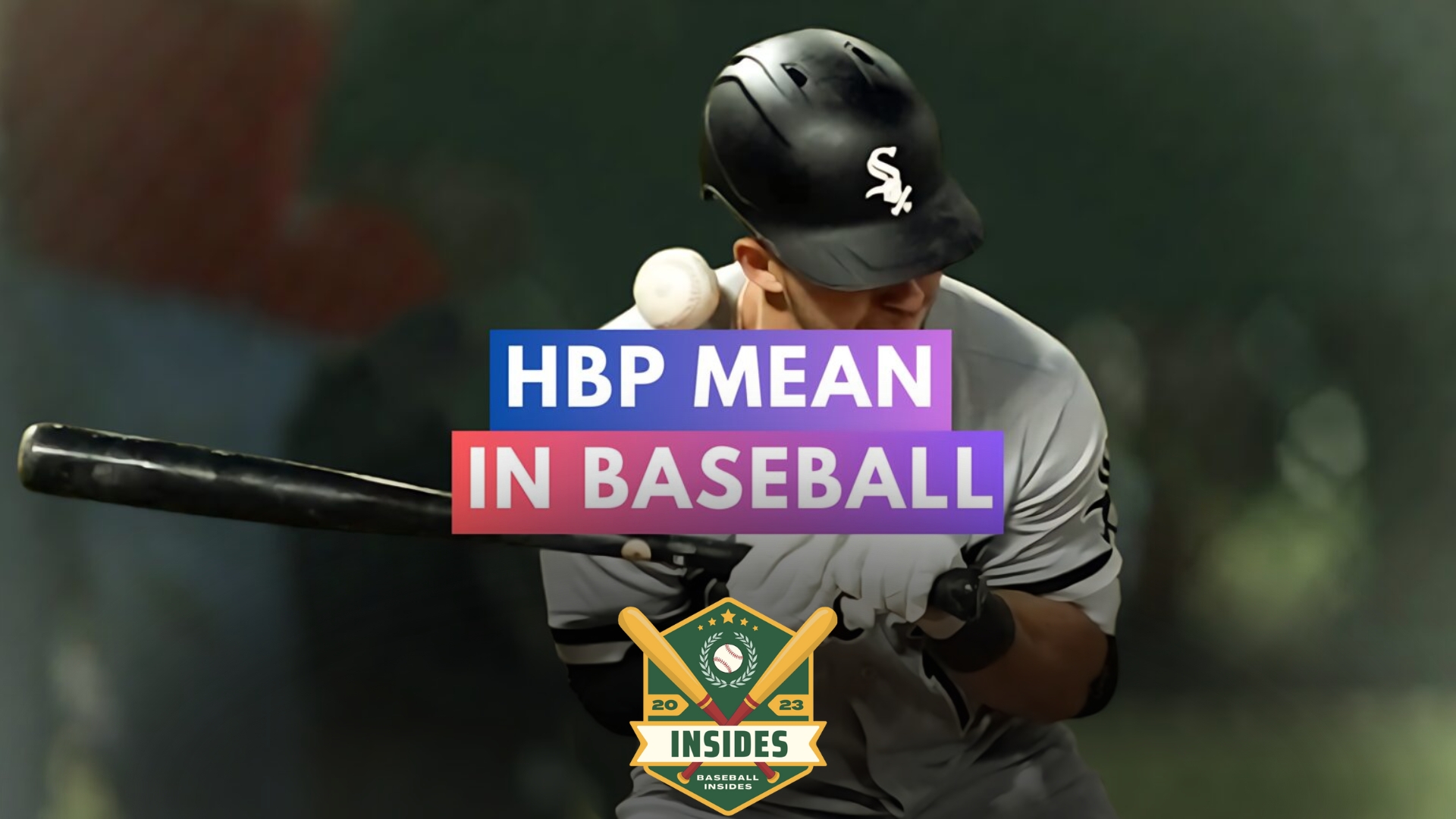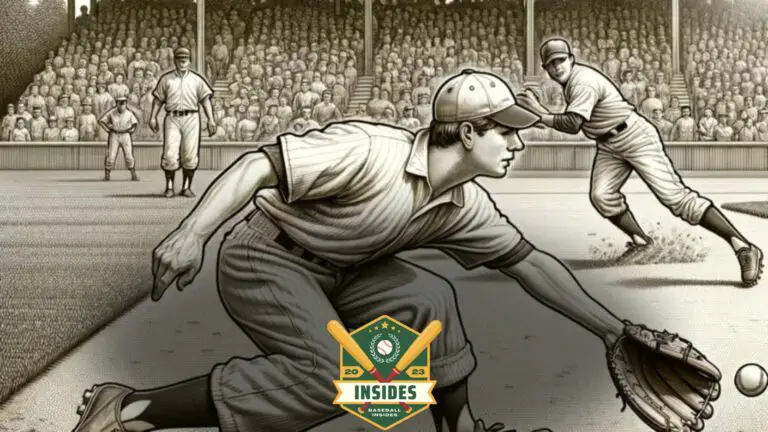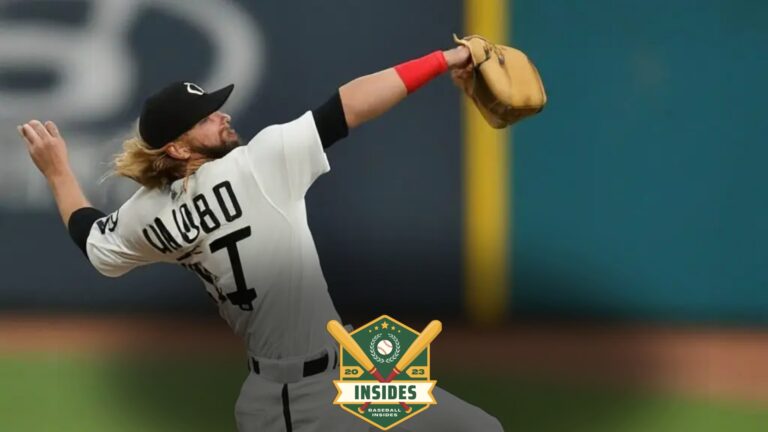
In this article:
Discovering the ins and outs of baseball terminology can be an exhilarating journey for both newcomers and seasoned fans alike.
Among the multitude of abbreviations and jargon used in the sport, “HBP” holds a prominent place. But what does HBP mean in baseball?
In this article, we will delve into the intricacies of this term and unveil its significance in the field. HBP, short for hit-by-pitch, occurs when a pitched ball strikes a batter without attempting to swing at it.
Consequently, the batter is granted the privilege of reaching first base.
However, it’s essential to note that not all instances of HBP are created equal. The ruling of a strike by the umpire or a batter’s swing can nullify the hit-by-pitch, showcasing the hierarchy of baseball’s rulebook.
Join us as we unravel the mysteries behind HBP, shedding light on its impact on the game.
What is a Hit by Pitch in Baseball?
In baseball, a “hit by pitch” refers to a situation where a batter is struck by a pitch thrown by the opposing pitcher. When a pitcher throws a pitch that unintentionally hits the batter, it is considered a hit-by pitch.
This can occur when the pitcher loses control of the ball or a pitch veers off its intended path due to wind or slippery conditions.
When a pitch hits a batter, they are awarded first base and are not required to attempt to swing at the pitch. The batter is not charged with an at-bat, and the pitch is not counted as a ball or a strike.
The batter is also not credited with a hit since they did not make contact with the ball.
There are a few situations where a hit-by-pitch can have additional implications. If the bases are loaded, the batter hit by a pitch is awarded an RBI (Run Batted In) since the hit by pitch allows a run to score.
Additionally, if the umpire determines that the pitch was intentional or in retaliation, the pitcher may be ejected from the game and face further disciplinary action from the league.
Hit by pitches are a part of the game and can occur for various reasons, including the pitcher’s control issues or the batter’s positioning close to the plate.
It is an important aspect of baseball to ensure player safety, and pitchers are expected to try to avoid hitting batters.
While discussing the excitement of baseball, it’s hard not to mention the thrill of a walkoff, a moment that can instantly turn a game on its head and leave fans in awe.
HBP Statistics and Records
Get ready to dive into the fascinating world of HBP statistics and records. While it may seem unusual to celebrate getting hit by a pitch, in baseball, it holds a special place in the game’s history.
So, let’s take a swing at exploring the mesmerizing numbers behind HBP (Hit By Pitch) and the players who have conquered this daring feat.
The journey through HBP statistics begins with a stroll down memory lane. Over the years, the frequency of batters being hit by pitches has seen its fair share of fluctuations.
From the early days of baseball to the modern era, we’ll explore how HBP trends have evolved, offering valuable insights into the changing dynamics of the game.
Prepare to be amazed by the fearless warriors who have fearlessly taken one for the team, time and time again. We’ll unveil the names of the all-time leaders in HBP, those gritty individuals who have endured countless pitches to earn their place in baseball history.
Discover the relentless players who have mastered the art of embracing pain in pursuit of victory.
Step up to the plate and witness records being shattered as we unravel the jaw-dropping accomplishments of players holding single-season and career HBP records.
From the staggering number of pitches absorbed in a single year to the remarkable endurance of batters who consistently took their base with courage, these records demonstrate the resilience and determination displayed by these remarkable athletes.
HBP in the Context of Baseball Strategy
In the strategic baseball battlefield, where every move counts, the Hit By Pitch (HBP) emerges as a hidden weapon that can tip the scales in a team’s favor.
Get ready to uncover the cunning tactics and crafty maneuvers employed by managers and players alike as we explore how HBP fits into the grand scheme of baseball strategy.
Offensive Strategies Utilizing HBP
Picture this: The bases are loaded, the tension is palpable, and a skilled batter approaches the plate. But instead of swinging for the fences, the team strategically utilizes HBP to gain an advantage.
We’ll delve into the intricate offensive strategies that leverage HBP to secure runs, disrupt the pitcher’s rhythm, and set the stage for a game-changing rally.
Uncover the mind games and calculated risks involved in harnessing the power of the HBP to outsmart the opponent.
Understanding a pitcher’s effectiveness is crucial, and that’s where the ERA (Earned Run Average) comes into play, offering insights into their performance beyond just wins and losses.
Defensive Strategies to Counter HBP
When faced with a team that skillfully employs HBP as part of their offensive arsenal, a manager must think on their feet and devise defensive strategies to neutralize the threat.
We’ll explore the art of pitching strategically to minimize HBP incidents, employing precise control and an array of pitches to keep the batter guessing.
Discover how teams adjust their fielding formations, defensive shifts, and communication on the diamond to counteract the strategic use of HBP.
Managerial Decisions Involving HBP
Behind the scenes, managers play a pivotal role in deciding when to deploy the HBP strategy.
We’ll dive into the intricate decision-making process, examining the factors managers consider when choosing to send a message with a well-placed pitch or when to opt for alternative tactics.
Explore the delicate balance between maintaining sportsmanship and utilizing HBP as a strategic tool as managers navigate the complex world of game management.
What Happens If You Get Hit By a Pitch?
If a pitch hits a batter in baseball, several things can happen depending on the specific circumstances:
- Hit-by-pitch (HBP): When a pitch hits a batter, it is called a hit-by-pitch or HBP. The batter is awarded first base and is credited with reaching base due to the pitcher’s mistake. The batter is not out and can advance to subsequent bases if other baserunners are forced to advance.
- Umpire’s discretion: Sometimes, the umpire may rule that the batter did not make an effort to avoid getting hit, resulting in a called strike instead of an HBP. This decision depends on the umpire’s judgment and can vary in different situations.
- Intentional hit-by-pitch: Occasionally, a pitcher intentionally throws at a batter, either as retaliation or to gain a strategic advantage. If the umpire determines that the pitcher intentionally hit the batter, they can eject the pitcher from the game and may issue warnings or further penalties to both teams.
- Injury: Getting hit by a pitch can cause varying degrees of injury, ranging from minor bruises to more severe consequences. The severity of the injury depends on factors such as the speed and location of the pitch, as well as the protective equipment worn by the batter.
- Base runner advancement: If there are other baserunners when a pitch hits a batter, they are generally entitled to advance one base. However, if all the bases are occupied, the batter would be awarded first base, and any other runners would advance accordingly.
It’s important to note that while being hit by a pitch is a part of the game, and pitchers generally aim to avoid hitting batters due to the potential consequences and the risk of escalating tensions between teams.
How Often Does a Pitch Hit Batters?
Batters being hit by a pitch, also known as a hit-by-pitch (HBP), is a relatively common occurrence in baseball.
The frequency of batters being hit by pitches varies depending on various factors, including the skill level of the pitchers, the pitching strategy employed, and the overall aggressiveness of the game.
On average, in Major League Baseball (MLB), there are typically around 0.40 hit-by-pitches per game. This figure can fluctuate from season to season and even within individual games.
The rate of HBP has seen some fluctuations over the years, with slight increases or decreases due to rule changes, adjustments in pitcher behavior, or other factors.
The number of HBP can also differ among leagues, such as Minor League Baseball or collegiate baseball. However, it is generally safe to say that batters being hit by pitches is a regular occurrence in the sport.
Getting hit by a pitch can have various implications for the game. Sometimes, it may be unintentional, occurring due to a pitcher’s lack of control or poor pitch execution.
In other cases, it can be a deliberate tactic employed by pitchers to intimidate or retaliate against opposing batters.
Regardless of the intention, when a pitch hits a batter, they are awarded first base. This can have strategic implications, such as advancing baserunners or altering the pitch sequence for subsequent batters.
Additionally, batters who frequently get hit by pitches may gain a reputation for their ability to “crowd the plate” and effectively disrupt pitchers’ rhythm.
Baseball is a game of intricacies, and one such complexity is the balk, a rule that can confuse newcomers but is vital in maintaining the game’s fairness between pitchers and baserunners.
How Do You Overcome the Fear of Getting Hit by a Pitch?
Overcoming the fear of getting hit by a pitch in baseball requires a combination of mental and physical strategies. Here are some tips to help you overcome this fear:
- Understand the odds: Remember that getting hit by a pitch is relatively rare in baseball. By understanding the statistics and realizing that the likelihood of getting hit is low, you can ease your fears.
- Focus on technique: Develop proper batting mechanics and practice your swing regularly. The more confident you are in hitting the ball, the less anxious you’ll be about getting hit.
- Visualize success: Use visualization techniques to imagine yourself successfully hitting the ball and avoiding getting hit. Visualizing positive outcomes can help reduce anxiety and build confidence.
- Face your fears gradually: Start by facing slower pitches or softer throws to gradually build your confidence. As you become more comfortable, gradually increase the speed and intensity of the pitches.
- Wear protective gear: Invest in quality protective equipment such as helmets and elbow guards. Knowing that you have the necessary protection can help alleviate fears.
- Seek support: Talk to your coaches, teammates, or a sports psychologist about your fear. They can guide, encourage, and support you to help you overcome it.
- Practice mindfulness: Learn relaxation techniques such as deep breathing and meditation to calm your mind and body before stepping up to bat.
Remember, overcoming fear takes time and patience. With consistent effort and a positive mindset, you can gradually overcome the fear of getting hit by a pitch and focus on enjoying the game of baseball.
Conclusion
In conclusion, HBP in baseball stands for “Hit By Pitch.” This term refers to a situation in which a pitch thrown by the pitcher strikes a batter. When a pitch hits a batter, they are awarded first base, regardless of whether they swung at the pitch.
HBP is an important statistic in baseball, as it can affect the game’s outcome by advancing baserunners and potentially creating scoring opportunities.
Additionally, being hit by a pitch can have strategic implications, as it can disrupt a pitcher’s rhythm or retaliate for a previous incident on the field.
FAQs
Why do pitchers try to hit batters?
Pitchers do not intentionally try to hit batters. Their main objective is to throw pitches within the strike zone to get batters out. However, in certain situations, pitchers may aim for the inside part of the plate to make batters uncomfortable or disrupt their timing.
This tactic, known as pitching inside, can prevent batters from extending their arms fully and generating power. It’s important to note that intentionally hitting batters is against the rules and can lead to penalties or ejections.
Does HBP count as an at bat?
No, a hit by pitch (HBP) does not count as an at bat in baseball. According to the official scoring rules, when a pitch hits a batter, it is recorded as a separate statistic and does not affect their at bat total.
Instead, the batter is awarded first base, and the HBP is tallied separately as a statistical category. At bats are only counted when a batter has a plate appearance that results in a hit, an out, a sacrifice, or a few other specific circumstances.
Who has the highest HBP in MLB?
As of my knowledge cutoff in September 2021, the MLB player with the highest number of hit by pitches (HBP) is Hughie Jennings. Jennings, a former professional baseball player who played primarily in the late 19th and early 20th centuries, holds the record for most career HBP. Throughout his career, he was hit by pitches a remarkable 287 times. It’s important to verify the current record holder, as player statistics may have changed since my last update.
Is a HBP a hit?
No, a hit by pitch (HBP) is not considered a hit in baseball. Although “hit” is part of the phrase, an HBP is recorded as a separate statistical category. A hit is typically defined as a fair ball that allows the batter to reach base safely without any defensive errors.
On the other hand, an HBP occurs when a pitched ball makes contact with the batter’s body, resulting in the batter being awarded first base. While both a hit and an HBP involve a batter reaching base, they are distinct statistical outcomes in baseball.






